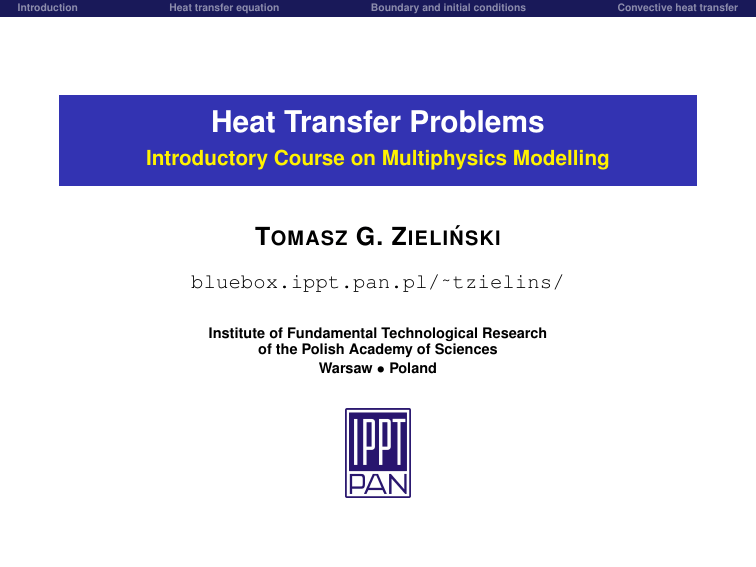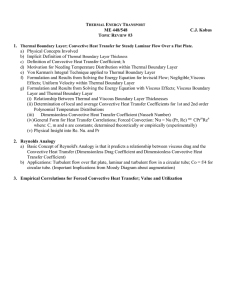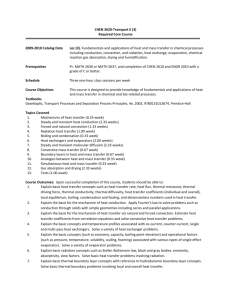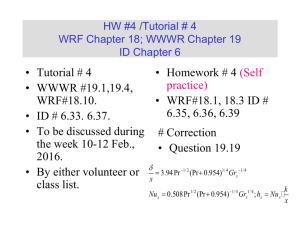
Introduction
Heat transfer equation
Boundary and initial conditions
Heat Transfer Problems
Introductory Course on Multiphysics Modelling
TOMASZ G. Z IELI ŃSKI
bluebox.ippt.pan.pl/˜tzielins/
Institute of Fundamental Technological Research
of the Polish Academy of Sciences
Warsaw • Poland
Convective heat transfer
Introduction
Heat transfer equation
Boundary and initial conditions
Outline
1
Introduction
Mechanisms of heat transfer
Heat conduction and the energy conservation principle
Convective heat transfer
Introduction
Heat transfer equation
Boundary and initial conditions
Outline
1
Introduction
Mechanisms of heat transfer
Heat conduction and the energy conservation principle
2
Heat transfer equation
Balance of thermal energy
Specific thermal energy
Fourier’s law
Heat equation
Convective heat transfer
Introduction
Heat transfer equation
Boundary and initial conditions
Outline
1
Introduction
Mechanisms of heat transfer
Heat conduction and the energy conservation principle
2
Heat transfer equation
Balance of thermal energy
Specific thermal energy
Fourier’s law
Heat equation
3
Boundary and initial conditions
Mathematical point of view
Physical interpretations
Initial-Boundary-Value Problem
Convective heat transfer
Introduction
Heat transfer equation
Boundary and initial conditions
Outline
1
Introduction
Mechanisms of heat transfer
Heat conduction and the energy conservation principle
2
Heat transfer equation
Balance of thermal energy
Specific thermal energy
Fourier’s law
Heat equation
3
Boundary and initial conditions
Mathematical point of view
Physical interpretations
Initial-Boundary-Value Problem
4
Convective heat transfer
Heat transfer by convection (and conduction)
Non-conservative convective heat transfer
Convective heat transfer
Introduction
Heat transfer equation
Boundary and initial conditions
Outline
1
Introduction
Mechanisms of heat transfer
Heat conduction and the energy conservation principle
2
Heat transfer equation
Balance of thermal energy
Specific thermal energy
Fourier’s law
Heat equation
3
Boundary and initial conditions
Mathematical point of view
Physical interpretations
Initial-Boundary-Value Problem
4
Convective heat transfer
Heat transfer by convection (and conduction)
Non-conservative convective heat transfer
Convective heat transfer
Introduction
Heat transfer equation
Boundary and initial conditions
Convective heat transfer
Three mechanisms of heat transfer
Heat transfer: a movement of energy due to a temperature difference.
Introduction
Heat transfer equation
Boundary and initial conditions
Convective heat transfer
Three mechanisms of heat transfer
Heat transfer: a movement of energy due to a temperature difference.
Thermal energy is transferred according to the following three mechanisms:
Conduction – heat transfer by diffusion in a stationary medium due to a
temperature gradient. The medium can be a solid or a liquid.
Introduction
Heat transfer equation
Boundary and initial conditions
Convective heat transfer
Three mechanisms of heat transfer
Heat transfer: a movement of energy due to a temperature difference.
Thermal energy is transferred according to the following three mechanisms:
Conduction – heat transfer by diffusion in a stationary medium due to a
temperature gradient. The medium can be a solid or a liquid.
Convection – heat transfer between either a hot surface and a cold
moving fluid or a hot moving fluid and a cold surface. Convection occurs
in fluids (liquids and gases).
Introduction
Heat transfer equation
Boundary and initial conditions
Convective heat transfer
Three mechanisms of heat transfer
Heat transfer: a movement of energy due to a temperature difference.
Thermal energy is transferred according to the following three mechanisms:
Conduction – heat transfer by diffusion in a stationary medium due to a
temperature gradient. The medium can be a solid or a liquid.
Convection – heat transfer between either a hot surface and a cold
moving fluid or a hot moving fluid and a cold surface. Convection occurs
in fluids (liquids and gases).
Radiation – heat transfer via electromagnetic waves between two
surfaces with different temperatures.
Introduction
Heat transfer equation
Boundary and initial conditions
Convective heat transfer
Three mechanisms of heat transfer
Heat transfer: a movement of energy due to a temperature difference.
Thermal energy is transferred according to the following three mechanisms:
Conduction – heat transfer by diffusion in a stationary medium due to a
temperature gradient. The medium can be a solid or a liquid.
Convection – heat transfer between either a hot surface and a cold
moving fluid or a hot moving fluid and a cold surface. Convection occurs
in fluids (liquids and gases).
Radiation – heat transfer via electromagnetic waves between two
surfaces with different temperatures.
Motivation for dealing with heat transfer problems:
In many engineering systems and devices there is often a need for
optimal thermal performance.
Most material properties are temperature-dependent so the effects
of heat transfer enter many other disciplines and drive the requirement
for multiphysics modeling.
Introduction
Heat transfer equation
Boundary and initial conditions
Convective heat transfer
Heat conduction and the energy conservation law
∂T
∂x
∂T
∂x
Problem: to find the temperature
in a solid, T = T(x, t) =? K .
·n>0
(warm)
n
·n<0
(cold)
∂B
B
(%, c, k)
heat source
f >0
heat sink
f <0
Temperature is related to heat
which is a form of energy.
The principle of conservation
of energy should be used to
determine the temperature.
Thermal energy can be: stored,
generated (or absorbed), and
supplied (transferred).
Introduction
Heat transfer equation
Boundary and initial conditions
Convective heat transfer
Heat conduction and the energy conservation law
∂T
∂x
∂T
∂x
Problem: to find the temperature
in a solid, T = T(x, t) =? K .
·n>0
(warm)
n
·n<0
(cold)
∂B
B
(%, c, k)
heat source
f >0
heat sink
f <0
Temperature is related to heat
which is a form of energy.
The principle of conservation
of energy should be used to
determine the temperature.
Thermal energy can be: stored,
generated (or absorbed), and
supplied (transferred).
The law of conservation of thermal energy
The rate of change of internal thermal energy with respect to time
in B is equal to the net flow of energy across the surface of B plus the
rate at which the heat is generated within B.
Introduction
Heat transfer equation
Boundary and initial conditions
Outline
1
Introduction
Mechanisms of heat transfer
Heat conduction and the energy conservation principle
2
Heat transfer equation
Balance of thermal energy
Specific thermal energy
Fourier’s law
Heat equation
3
Boundary and initial conditions
Mathematical point of view
Physical interpretations
Initial-Boundary-Value Problem
4
Convective heat transfer
Heat transfer by convection (and conduction)
Non-conservative convective heat transfer
Convective heat transfer
Introduction
Heat transfer equation
Boundary and initial conditions
Convective heat transfer
Balance of thermal energy
The internal thermal energy, E J :
Z
% e dV
% = %(x) – the mass density kg
m3
B
e = e(x, t) – the specific
internal energy kgJ
Introduction
Heat transfer equation
Boundary and initial conditions
Convective heat transfer
Balance of thermal energy
•
The rate of change of thermal energy, E = dE
dt W :
Z
Z
d
∂e
dV
% e dV = %
% = %(x) – the mass density mkg3
dt
∂t
B
B
e = e(x, t) – the specific
internal energy kgJ
Introduction
Heat transfer equation
Boundary and initial conditions
Convective heat transfer
Balance of thermal energy
•
The rate of change of thermal energy, E = dE
dt W :
Z
Z
d
∂e
dV
% e dV = %
% = %(x) – the mass density mkg3
dt
∂t
B
B
e = e(x, t) – the specific
internal energy kgJ
The flow of heat, Q W (the amount of heat per unit time
flowing-inZacross the boundary ∂B):
−
∂B
q · n dS
q = q(x, t) – the heat flux vector
W
m2
n – the outward normal vector
Introduction
Heat transfer equation
Boundary and initial conditions
Convective heat transfer
Balance of thermal energy
•
The rate of change of thermal energy, E = dE
dt W :
Z
Z
d
∂e
dV
% e dV = %
% = %(x) – the mass density mkg3
dt
∂t
B
B
e = e(x, t) – the specific
internal energy kgJ
The flow of heat, Q W (the amount of heat per unit time
flowing-inZacross the boundary ∂B):
−
q · n dS
∂B
q = q(x, t) – the heat flux vector
W
m2
n – the outward normal vector
The total rate of heat production, F W (the amount of heat per
unit time produced
in B by the volumetric heat sources):
Z
f dV
B
f = f (x, t) – the rate of heat production
per unit volume mW3
Introduction
Heat transfer equation
Boundary and initial conditions
Convective heat transfer
Balance of thermal energy
•
The thermal energy conservation law, E = Q + F, leads to the following
balance equation.
The global form of thermal energy balance
Z
%
B
∂e
dV = −
∂t
Z
∂B
Z
q · n dS +
f dV
B
Introduction
Heat transfer equation
Boundary and initial conditions
Convective heat transfer
Balance of thermal energy
•
The thermal energy conservation law, E = Q + F, leads to the following
balance equation.
The global form of thermal energy balance
Z
%
B
∂e
dV = −
∂t
Z
Z
∇ · q dV +
B
f dV
B
(after using the divergence theorem)
Introduction
Heat transfer equation
Boundary and initial conditions
Convective heat transfer
Balance of thermal energy
•
The thermal energy conservation law, E = Q + F, leads to the following
balance equation.
The global form of thermal energy balance
Z %
B
∂e
+∇·q−f
∂t
dV = 0 .
Assuming the continuity of the above integral and using the fact that this
equality holds not only for the whole domain B, but also for its every single
subdomain the following PDE is obtained.
The local form of thermal energy balance
%
∂e
+∇·q=f
∂t
in B .
The unknown fields are: e = e(x, t) =?, q = q(x, t) =?.
The fields are related to the unknown temperature T = T(x, t) =?.
The relations e = e(T) and q = q(T) are to be established and applied.
Introduction
Heat transfer equation
Boundary and initial conditions
Convective heat transfer
Specific thermal energy: a constitutive relation
Observation:
For many materials, over fairly wide (but not too large)
temperature ranges, the specific thermal energy depends
linearly on the temperature.
Introduction
Heat transfer equation
Boundary and initial conditions
Convective heat transfer
Specific thermal energy: a constitutive relation
Observation:
For many materials, over fairly wide (but not too large)
temperature ranges, the specific thermal energy depends
linearly on the temperature.
Specific thermal energy vs. temperature
∂e
∂T
=c
∂t
∂t
where c = c(x, t) is the thermal capacity
J
kg·K
.
Introduction
Heat transfer equation
Boundary and initial conditions
Convective heat transfer
Specific thermal energy: a constitutive relation
Specific thermal energy vs. temperature
∂e
∂T
=c
∂t
∂t
where c = c(x, t) is the thermal capacity
J
kg·K
.
The thermal capacity is also called the specific heat capacity (at a
constant pressure), or simply, the specific heat).
It describes the ability of a material to store the heat and refers to the
quantity that represents the amount of heat required to change the
temperature of one unit of mass by one degree.
(Isobaric mass) thermal capacity
h
Material
Aluminium
Steel
Glass
c
J
kg·K
i
897
466
84
Water (solid: ice at −10◦ C)
Water (liquid at 25◦ C)
Water (gas: steam at 100◦ C)
2 110
4 181
2 080
Air (at room conditions)
1 012
Introduction
Heat transfer equation
Boundary and initial conditions
Convective heat transfer
Fourier’s law of heat conduction
Observations:
the heat flows from regions of high temperature to regions of
low temperature,
the rate of heat flow is bigger if the temperature differences
(between neighboring regions) are larger.
Introduction
Heat transfer equation
Boundary and initial conditions
Convective heat transfer
Fourier’s law of heat conduction
Observations:
the heat flows from regions of high temperature to regions of
low temperature,
the rate of heat flow is bigger if the temperature differences
(between neighboring regions) are larger.
Postulate: there is a linear relationship between the rate of
heat flow and the rate of temperature change.
Fourier’s law of heat conduction
q = −k ∇T
where k = k(x) is the thermal conductivity
W
m·K
.
Introduction
Heat transfer equation
Boundary and initial conditions
Convective heat transfer
Fourier’s law of heat conduction
Postulate: there is a linear relationship between the rate of
heat flow and the rate of temperature change.
Fourier’s law of heat conduction
q = −k ∇T
where k = k(x) is the thermal conductivity
The thermal conductivity is a material
constant that describes the ability of a
material to conduct the heat.
If the thermal conductivity is anisotropic,
k becomes a (second order) thermal
conductivity tensor.
W
m·K
.
Thermal conductivity
h
i
W
k m·K
Material
Aluminium
Steel (carbon)
Steel (stainless)
Glass
Water (liquid)
Air (gas)
220
50
18
1.0
0.6
0.025
Introduction
Heat transfer equation
Boundary and initial conditions
Convective heat transfer
Derivation of the heat equation
Energy vs. temp.
∂T
∂e
=c
∂t
∂t
Energy conservation law
%
∂e
+∇·q=f
∂t
Fourier’s law
q = −k ∇T
Introduction
Heat transfer equation
Boundary and initial conditions
Convective heat transfer
Derivation of the heat equation
Energy vs. temp.
Energy conservation law
∂T
∂e
=c
∂t
∂t
%
∂e
+∇·q=f
∂t
Fourier’s law
q = −k ∇T
Heat conduction equation
%c
∂T
− ∇ · (k ∇T) = f
∂t
where the only unknown is the temperature: T(x, t) =?
Introduction
Heat transfer equation
Boundary and initial conditions
Convective heat transfer
Derivation of the heat equation
Energy vs. temp.
Energy conservation law
∂T
∂e
=c
∂t
∂t
%
Fourier’s law
∂e
+∇·q=f
∂t
q = −k ∇T
Heat conduction equation
%c
∂T
− ∇ · (k ∇T) = f
∂t
where the only unknown is the temperature: T(x, t) =?
Thermally-homogeneous material: For k(x) = const. the heat PDE
can be presented as follows
∂T
= α2 4T + f̃
∂t
where
α2 =
Here: α2 = α2 (x) is the thermal diffusivity
k
%c
m2 and
f̃ =
f
.
%c
,
f̃ = f̃ (x, t) is the rate of change of temperature Ks
due to internal heat sources.
s
Introduction
Heat transfer equation
Boundary and initial conditions
Outline
1
Introduction
Mechanisms of heat transfer
Heat conduction and the energy conservation principle
2
Heat transfer equation
Balance of thermal energy
Specific thermal energy
Fourier’s law
Heat equation
3
Boundary and initial conditions
Mathematical point of view
Physical interpretations
Initial-Boundary-Value Problem
4
Convective heat transfer
Heat transfer by convection (and conduction)
Non-conservative convective heat transfer
Convective heat transfer
Introduction
Heat transfer equation
Boundary and initial conditions
Convective heat transfer
Boundary conditions
The mathematical point of view
From the point of view of mathematics there are three kinds of
boundary conditions:
1 the first kind or Dirichlet b.c. – to set a temperature, T̂ K , on a
boundary:
T = T̂ on ∂BT ,
Here, ∂BT , ∂Bq , and ∂Bh are mutually disjoint, complementary parts of the
boundary ∂B.
Introduction
Heat transfer equation
Boundary and initial conditions
Convective heat transfer
Boundary conditions
The mathematical point of view
From the point of view of mathematics there are three kinds of
boundary conditions:
1 the first kind or Dirichlet b.c. – to set a temperature, T̂ K , on a
boundary:
T = T̂ on ∂BT ,
2
the
second kind or Neumann b.c. – to set an inward heat flux,
q̂ W , normal to the boundary:
−q(T) · n = q̂
on ∂Bq ,
Here, ∂BT , ∂Bq , and ∂Bh are mutually disjoint, complementary parts of the
boundary ∂B.
Introduction
Heat transfer equation
Boundary and initial conditions
Convective heat transfer
Boundary conditions
The mathematical point of view
From the point of view of mathematics there are three kinds of
boundary conditions:
1 the first kind or Dirichlet b.c. – to set a temperature, T̂ K , on a
boundary:
T = T̂ on ∂BT ,
2
the
second kind or Neumann b.c. – to set an inward heat flux,
q̂ W , normal to the boundary:
−q(T) · n = q̂
3
on ∂Bq ,
the third kind or Robin (or generalized Neumann) b.c. – to
specify the heat flux in terms of an explicit
heat flux, q̂, and a
convective heat transfer coefficient, h mW
2 ·K , relative to a
reference temperature, T̂:
−q(T) · n = q̂ + h (T̂ − T) on ∂Bh .
Here, ∂BT , ∂Bq , and ∂Bh are mutually disjoint, complementary parts of the
boundary ∂B.
Introduction
Heat transfer equation
Boundary and initial conditions
Convective heat transfer
Boundary conditions
The physical interpretations
Prescribed temperature : T = T̂
Along a boundary the specified temperature, T̂, is maintained (the
surrounding medium is thermostatic).
Use the Dirichlet b.c. Specify: T̂.
Introduction
Heat transfer equation
Boundary and initial conditions
Convective heat transfer
Boundary conditions
The physical interpretations
Prescribed temperature : T = T̂
Use the Dirichlet b.c. Specify: T̂.
Insulation or symmetry : −q(T) · n = 0
To specify where a domain is well insulated, or to reduce model size by
taking advantage of symmetry. The condition means that the temperature
gradient across the boundary must equal zero. For this to be true, the
temperature on one side of the boundary must equal the temperature on
the other side (heat cannot transfer across the boundary if there is no
temperature difference).
Use the (homogeneous) Neumann b.c. with q̂ = 0.
Introduction
Heat transfer equation
Boundary and initial conditions
Convective heat transfer
Boundary conditions
The physical interpretations
Prescribed temperature : T = T̂
Use the Dirichlet b.c. Specify: T̂.
Insulation or symmetry : −q(T) · n = 0
Use the (homogeneous) Neumann b.c. with q̂ = 0.
Conductive heat flux : −q(T) · n = q̂
To specify a heat flux, q̂, that enters a domain. This condition is well
suited to represent, for example, any electric heater (neglecting its
geometry).
Use the Neumann b.c. Specify: q̂.
Introduction
Heat transfer equation
Boundary and initial conditions
Convective heat transfer
Boundary conditions
The physical interpretations
Prescribed temperature : T = T̂
Use the Dirichlet b.c. Specify: T̂.
Insulation or symmetry : −q(T) · n = 0
Use the (homogeneous) Neumann b.c. with q̂ = 0.
Conductive heat flux : −q(T) · n = q̂
Use the Neumann b.c. Specify: q̂.
Convective heat flux : −q(T) · n = h (T̂ − T)
To model convective heat transfer with the surrounding environment,
where the heat transfer coefficient, h, depends on the geometry and the
ambient flow conditions; T̂ is the external bulk temperature.
Use the Robin b.c. with q̂ = 0. Specify: h and T̂.
Introduction
Heat transfer equation
Boundary and initial conditions
Convective heat transfer
Boundary conditions
The physical interpretations
Prescribed temperature : T = T̂
Use the Dirichlet b.c. Specify: T̂.
Insulation or symmetry : −q(T) · n = 0
Use the (homogeneous) Neumann b.c. with q̂ = 0.
Conductive heat flux : −q(T) · n = q̂
Use the Neumann b.c. Specify: q̂.
Convective heat flux : −q(T) · n = h (T̂ − T)
Use the Robin b.c. with q̂ = 0. Specify: h and T̂.
Heat flux from convection and conduction : −q(T) · n = q̂ + h (T̂ − T)
Heat is transferred by convection and conduction. Both contributions are
significant and none of them can be neglected. Notice that the conduction
heat flux, q̂, is in the direction of the inward normal whereas the
convection term, h (T̂ − T), in the direction of the outward normal.
Use the Robin b.c. Specify: h, T̂, and q̂.
Introduction
Heat transfer equation
Boundary and initial conditions
Convective heat transfer
Initial-Boundary-Value Problem
IBVP of the heat transfer
Find T = T(x, t) for x ∈ B and t ∈ [t0 , t1 ] satisfying the heat equation:
•
%cT + ∇ · q − f = 0
where
q = q(T) = −k ∇T ,
with the initial condition (at t = t0 ):
T(x, t0 ) = T0 (x) in B ,
and subject to the boundary conditions:
T(x, t) = T̂(x, t) on ∂BT ,
−q(T) n = q̂(x, t) on ∂Bq ,
−q(T) · n = q̂ + h (T̂ − T) on ∂Bh ,
where ∂BT ∪ ∂Bq ∪ ∂Bh = ∂B, and the parts of boundary ∂B are
mutually disjoint: ∂BT ∩ ∂Bq = ∅, ∂BT ∩ ∂Bh = ∅, ∂Bq ∩ ∂Bh = ∅.
Introduction
Heat transfer equation
Boundary and initial conditions
Outline
1
Introduction
Mechanisms of heat transfer
Heat conduction and the energy conservation principle
2
Heat transfer equation
Balance of thermal energy
Specific thermal energy
Fourier’s law
Heat equation
3
Boundary and initial conditions
Mathematical point of view
Physical interpretations
Initial-Boundary-Value Problem
4
Convective heat transfer
Heat transfer by convection (and conduction)
Non-conservative convective heat transfer
Convective heat transfer
Introduction
Heat transfer equation
Boundary and initial conditions
Convective heat transfer
Heat transfer by convection (and conduction)
An important mechanism of heat transfer in fluids is convection.
Heat can be transferred with fluid in motion.
In such case, a convective
term containing the convective
velocity vector, u ms , must be added to the Fourier’s law of heat
conduction:
q = −k ∇T + % c u T .
Introduction
Heat transfer equation
Boundary and initial conditions
Convective heat transfer
Heat transfer by convection (and conduction)
An important mechanism of heat transfer in fluids is convection.
Heat can be transferred with fluid in motion.
In such case, a convective
term containing the convective
velocity vector, u ms , must be added to the Fourier’s law of heat
conduction:
q = −k ∇T + % c u T .
(Conservative) heat transfer equation with convection
c
∂ (% T)
+ ∇ · (−k ∇T + % c u T) = f .
∂t
Notice that here the density is allowed to be time-dependent,
% = %(x, t), since it can change in time and space due to the fluid
motion causing local compressions and decompressions.
Introduction
Heat transfer equation
Boundary and initial conditions
Convective heat transfer
Non-conservative convective heat transfer
For homogeneous, incompressible fluid:
∇·u=0
→
%(x, t) = const .
This assumption produces the following result
∇ · (% c u T) = % c ∇T · u + T ∇ · (% c u) = % c ∇T · u .
|
{z
}
0
Introduction
Heat transfer equation
Boundary and initial conditions
Convective heat transfer
Non-conservative convective heat transfer
For homogeneous, incompressible fluid:
∇·u=0
→
%(x, t) = const .
This assumption produces the following result
∇ · (% c u T) = % c ∇T · u + T ∇ · (% c u) = % c ∇T · u .
|
{z
}
0
Non-conservative heat transfer equation with convection
%c
∂T
− ∇ · (k ∇T) + % c ∇T · u = f ,
∂t
or, for k(x) = const .:
∂T
= f̃ + α2 4T − ∇T · u .
∂t





